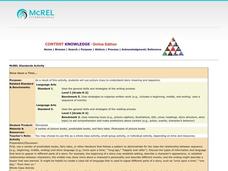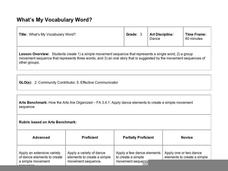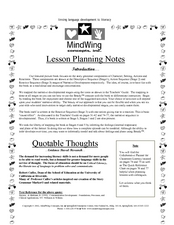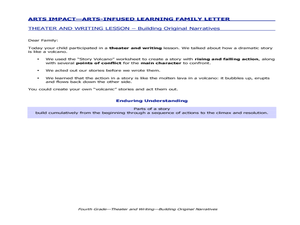Curated OER
Once Upon a Time...
Model for emergent readers how to write a story by interpreting picture clues. For guided practice a second book is used, and then pupils work independently or with an adult to write their own stories based on illustrations.
Hawaiʻi State Department of Education
What’s My Vocabulary Word?
The elements of dance can be used to communicate thoughts and, in this case, words. In small groups, the class first creates a set of movements to show a single word. Then, they extend their movements to show a three-word phrase....
Curated OER
A Soldier's View of the American Civil War
Study and research the American Civil War in this explanatory writing lesson. Middle schoolers complete six activities to learn about the American Civil War and soldiers' views of the war. The lesson includes several options to complete...
Curated OER
The Personal Narrative - Part One
Read to write! The class lists sensory details based on the plot of a story they have recently read. They create a drawing of a bracelet and use the bracelet's jewels or charms to list sensory details included in the story. They then use...
Curated OER
Order! Order!
Polish organization skills in your youngsters. With this lesson plan, they are introduced to the trait of organization and participate in activities that reinforce organization. They cut apart a familiar story, receive different parts of...
Curated OER
Comprehension: Create a Summary from a Narrative Text
If your class can sequence events in a story, are pretty good at retell, and can identify the main point, they are probably ready for reading comprehension through summarizing. This lesson provides a teacher's script that facilitates...
Curated OER
The "Write" Stuff: Strategies and Conventions for Imaginative Writing
Fifth graders develop and practice the steps involved in imaginative writing. They follow the steps/worksheets included and write imaginative stories of their own.
Curated OER
The Things That Bothered Farmer Brown
Link language development to literacy skills. This lesson template provides a comprehensible way to use the Braidy Web to maximize language and reading skills. It would be appropriate for developmentally disabled pupils reading at a K-2...
Curated OER
Animal Diaries
Launch this lesson with Doreen Cronin's Diary of a Worm! Discuss the format and content of a diary, and ask learners if they've ever kept a diary before. Then, after an introductory discussion, have learners choose an insect or another...
Curated OER
Building Original Narratives
Fourth graders act out and write original narratives. In this theater meets writing lesson, 4th graders work in groups to create original narratives; after students act out their story, they write it down as a narrative.
Hawaiʻi State Department of Education
Cinderella
Reading fairy tales is so much fun! Learners use dramatic play to assist them in defining and expressing the main theme found in the story of Cinderella. Each group is given a story card and will create a tableau based on the main point...
Curated OER
Aboriginal Legends
Students listen to and read legends and see that these legends helped the Aboriginals explain their everyday life. Through their stories and legends we find that Aboriginal values, attitudes and cultural identities are shared.
Curated OER
Moby Dick Puppetry
Such an ambitious lesson! Third graders with special needs listen to an audio recording of the novel, Moby Dick. They stop often to discuss each of the main characters and analyze their actions in the story. They then make puppets of one...
Curated OER
Personal Experience Narratives
Help your middle schoolers identify personal experience narratives in their own lives through telling stories themselves and from family members or other adults. They study personal experience narratives in Swapping Stories and compare...
Curated OER
Flip and Flop: An Adaptation Through Dancing Echoes with Shapes and Locomotor Movement
Dancers practice echoing through dance. They listen to a story "Flip and Flop" and then are put into pairs. One partner is Flip, while the other is Flop. Flip creates a shape by dancing, and Flop, the other student, echoes that shape by...
Curated OER
Chicka Chicka Boom Boom
Young readers write alphabet letters. They review the alphabet and examine the relationship between letters and sounds. A final activity has each child sequence the story together.
Curated OER
Guided Reading with David's Drawings by Cathryn Falwell
First graders participate in a guided reading lesson. In this guided reading lesson, 1st graders read David's Drawings by Cathryn Falwell, which is a realistic fiction book on the DRA:16 level. They determine the author's message, and...
Curated OER
Narrative Writing vs. Explanatory Writing
The class discusses the different purposes an author has for writing. The focus of the discussion is on writing to tell a true story and writing to give information about a specific topic. There are writing purpose sorting cards embedded...
Curated OER
Crater Creation
After looking at the back of a quarter featuring Oregon terrain, learners distinguish between fiction and non-fiction and identify the beginning, middle and end of a story. First, they listen to legends that describe the creation of...
Curated OER
Comprehension: Create a Summary from an Expository Text
Children can learn to analyze expository or informational texts at nearly any age. This scaffolded and scripted resource provides teachers with the support needed to facilitate a thoughtful lesson on summarizing informational text by...
Foreign Policy Research Institute
Exploring Korea
A thorough and fun lesson on Korea! In groups of four (Social Chair, Historian, Translator, Travel Agent) class members research North and South Korea to determine a good location for an overseas institute for studying abroad. Once this...
Curated OER
International Children's Book Day
Celebrate International Children's Book Day using this resource. Learners complete activities, such as reading a passage, sequencing, unscrambling sentences, writing questions, conducting surveys, and writing. Students complete twelve...
Curated OER
The Personal Narrative - Part Five
Create a class anthology with your young writers. In this personal narrative lesson, each writer reflects on actions and events from their own lives and chronicles them in a three-part written sequence. They create a table of contents...
Hawaiʻi State Department of Education
Dance Critic
What do writing and dance have in common? They both have a six-trait rubric for assessment. Just like a good story, a good dance must have a hook, beginning, middle, end, logical sequence, and a climax. Learners use a structured...

























